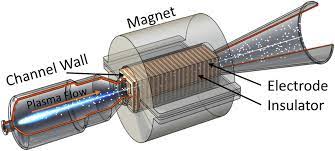MHD Generators(Magnetohydrodynamic generators)
MHD generators, or magnetohydrodynamic generators, are a unique and exciting area of energy and power generation. They use a combination of magnetic fields and electrically conductive fluids, like molten metal or plasma, to produce electricity. But, how exactly do they work and what goes into building one? In this blog post, we'll dive into the details of MHD generators and explore their potential applications and advantages over traditional power generation methods.
First, let's talk about how MHD generators work. A magnetic field is applied to a conductive fluid, and this creates an electric current within the fluid. As the fluid moves through the magnetic field, a voltage difference is also created, and it's this voltage difference that we use to generate electricity. The fluid is typically heated to high temperatures to increase its conductivity and make it more efficient at generating electricity.
Now, you might be thinking, "That sounds pretty cool, but how do I go about building one of these things?" The answer is, it's not easy. Building an MHD generator requires a few key components and some precise design considerations. Here's a rundown of what you'll need:
A magnetic field source: This could be a permanent magnet or an electromagnet, depending on the design. The strength of the magnetic field will affect the efficiency of the generator, so it's important to choose a suitable magnet.
A conductive fluid: This could be a liquid metal, such as sodium or potassium, or a plasma created by heating a gas to extremely high temperatures. The fluid should have a high electrical conductivity and a suitable operating temperature range.
A container: This would hold the conductive fluid and the magnetic field source. It would need to be made of a material that can withstand the high temperatures and pressures of the fluid.
Power handling equipment: This would include things like heat exchangers, pumps, and transformers to safely convert the electrical energy generated by the MHD generator into a usable form.
It's important to note that MHD generator technology is not yet mature and not yet available for commercial use. Building a MHD generator requires a lot of calculations and precise measurements, as well as a good understanding of the math and physics behind it all.
But, even though MHD generators aren't quite ready for commercial use yet, there are still some potential advantages over traditional power generation methods. For example, MHD generators can operate at much higher temperatures and can potentially be more efficient. Additionally, they don’t have moving parts, which means less maintenance is required.
However, there are also some drawbacks to MHD generators. For one, they require high temperatures and high pressures to operate, which can be difficult and dangerous to achieve and maintain. This makes them challenging and expensive to construct and operate. Additionally, the conductive fluid must be contained, which can be difficult and expensive.
One company working on MHD generator technology is NELT, a US-based company that is researching and developing MHD generators. They are making progress in the field and are one of the few companies working on this technology.
In conclusion, MHD generators are a unique and exciting area of energy and power generation, but the technology is still in the research phase and not yet available for commercial use. They have the potential to be more efficient and have a lot of applications, but it is important to consider the difficulties and expenses involved in building and operating them. Companies like NELT are making progress in this field and it will be interesting to see how the technology develops in the future.






Comments
Post a Comment